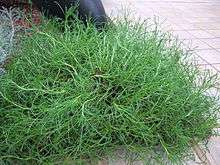Santolina rosmarinifolia
| Santolina rosmarinifolia | |
|---|---|
 | |
| Scientific classification | |
| Kingdom: | Plantae |
| (unranked): | Angiosperms |
| (unranked): | Eudicots |
| (unranked): | Asterids |
| Order: | Asterales |
| Family: | Asteraceae |
| Tribe: | Anthemideae |
| Genus: | Santolina |
| Species: | S. rosmarinifolia |
| Binomial name | |
| Santolina rosmarinifolia L. | |
Santolina rosmarinifolia, the holy flax,[1] is a species of flowering plant in the daisy family Asteraceae, native to south western Europe. It is a dense, compact evergreen shrub growing to 60 cm (24 in) tall and wide, with narrow, aromatic green leaves and tight yellow composite flowerheads carried on slender stalks above the foliage, in summer.[2]
The specific epithet rosmarinifolia describes the leaves' passing resemblance to those of rosemary, a distantly related group of plants.[3]
In cultivation it is useful as groundcover or as an edging plant for sunny, well-drained situations. It dislikes winter wetness, and can be short-lived. The dwarf cultivar S. rosmarinifolia subsp. rosmarinifolia 'Primrose Gem' has gained the Royal Horticultural Society's Award of Garden Merit.[4]
References
- ↑ "Plants for a future - Santolina rosmarinifolia". Retrieved 2 June 2013.
- ↑ RHS A-Z encyclopedia of garden plants. United Kingdom: Dorling Kindersley. 2008. p. 1136. ISBN 1405332964.
- ↑ Harrison, Lorraine (2012). RHS Latin for gardeners. United Kingdom: Mitchell Beazley. p. 224. ISBN 9781845337315.
- ↑ "RHS Plant Selector - Santolina rosmarinifolia subsp. rosmarinifolia 'Primrose Gem'". Retrieved 2 June 2013.
- J. Rodriguez-Oubiña and S. Ortiz (2008). A new subspecies of Santolina rosmarinifolia L.(Asteraceae) from serpentine soils in Central Galicia (NW Iberian Peninsula), Botanical Journal of the Linnean Society, Volume 111 Issue 4.